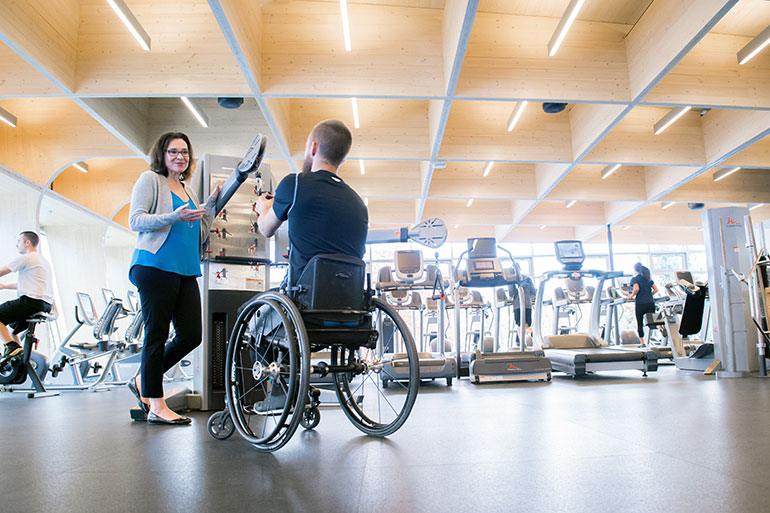
UBC Okanagan Professor Kathleen Martin Ginis chats about physical activity with tennis player and UBC student Rob Shaw.
International, systematic project reveals recommended dose of weekly exercise
For decades, the main message to keep the general population healthy was for everyone to get active.
In fact, the World Health Organization laid out specific guidelines (150 minutes of cardiovascular exercise each week) on how much physical activity was required for people to maintain a healthy lifestyle. However, UBC Okanagan researcher Kathleen Martin Ginis says while the recommendations were well-meaning, a particular group of people was excluded.
“These guidelines were never specifically tailored for people with spinal cord injuries (SCI),” says Martin Ginis. “Not only were people with SCI essentially excluded from the systematic review that came up with these specific physical activity guidelines, but the potential risks to the SCI population—including upper body over-use, skin breakdown, autonomic dysreflexia (sudden high blood pressure), and overheating—were not considered.”
Now, an international committee, led by Martin Ginis, has come up with exercise recommendations for the SCI population that will be presented at the International Spinal Cord Society Annual Scientific Meeting in Dublin, Ireland this week.
“These guidelines represent an important step toward international harmonization of exercise guidelines for adults with SCI,” says Martin Ginis. “At the same time, they are a clear foundation for developing exercise policies and programs for people with SCI around the world.”
It is recommended that to improve fitness, adults with SCI should engage in at least 20 minutes of moderate to vigorous intensity aerobic exercise two times week and three sets of moderate strengthening exercise for each major functional muscle groups two times per week. To improve cardiometabolic health, at least 30 minutes of moderate to vigorous intensity aerobic exercise is needed, three times per week.
It’s a specific dose, she adds, for a reason. Cardiometabolic illnesses—cardiovascular disease, diabetes and even obesity—are among the leading causes of death in adults with SCI and addressing cardiometabolic health is extremely valuable, she adds.
“These exercise guidelines have been systematically developed,” says Martin Ginis. “And we are now able to say, that this specific dose of exercise is safe and can have significant fitness and cardiometabolic health benefits for adults with spinal cord injuries.”
To determine the exact prescription, the international team looked at more than 200 previously published studies; all of which examined the effects of exercise interventions (e.g., cardio, strength-training) on cardiorespiratory fitness, muscle strength, bone health, body composition and cardiovascular risk factors for people with spinal cord injury. Stakeholder groups, people with SCI, and exercise scientists were also consulted.
The study was partially funded by the Rick Hansen Institute (RHI), a Canadian-based not-for-profit organization that drives innovation in spinal cord injury research and care. Hansen, a three-time Paralympic gold medalist, says these guidelines will make a significant difference to the lives of many people.
“The Rick Hansen Foundation created the RHI to support leading and applied research that would produce tangible results that when applied will improve lives of people with spinal cord injury,” says Hansen. “By applying these guidelines, people with SCI can expect to reach closer to normal health outcomes and lead full and meaningful lives. I am very proud of the work produced by Dr. Martin Ginis and her dedicated team.”
The research is published this week in the journal Spinal Cord. Other funders include Loughborough University, the UK Higher Education Institute, and the Social Sciences and Humanities Research Council of Canada.
About UBC’s Okanagan campus
UBC’s Okanagan campus is an innovative hub for research and learning in the heart of British Columbia’s stunning Okanagan Valley. Ranked among the top 20 public universities in the world, UBC is home to bold thinking and discoveries that make a difference. Established in 2005, the Okanagan campus combines a globally recognized UBC education with a tight-knit and entrepreneurial community that welcomes students and faculty from around the world. For more visit ok.ubc.ca.